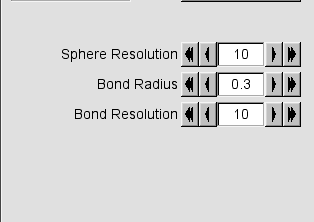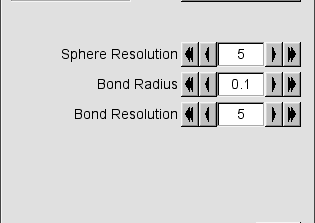Talk:Mod:Hunt Research Group/vmd
Graphical representation
using commands
- example for a standard CPK representation
- mol selection {all}
- mol representation CPK 1.100000 0.300000 20.000000 16.000000
- mol color Name
- mol addrep top
- what this does
- select everything
- CPK is VDW and bonds
- sphere_scale=1.1 bond_radius=0.3 sphere_res=20 bond_resolution=16
- select how colour is choosen
- now apply the changes
- other representations include
- mol representation CPK 1.15 0.3 30.0 16.0
- sphere scale, sphere resolution, bond radius, bond resolution
- mol representation VDW 0.30 30.0
- sphere scale, sphere resolution
- mol representation DynamicBonds 1.200000 0.200000 12.000000
- distance cut-off, bond radius, bond resolution
- mol representation HBonds 3.0 30.0 3.0
- more complex selections
- for example atoms within 2.89 of central Cl that are H atoms ie (Cl-H rdf)
- mol selection (within 2.89 of element Cl) and name "H"
- mol color ColorID 2
- mol addrep top
using the gui
When working in the Graphical representations box you should be aware that any changes made (as described below) will affect the file which is shown in the Selected molecule box. In order to be consistent any changes you make will need to be repeated for any other files you have loaded. This is particularly relevant when overlaying structures.
Structure model
The wireframe representation can be difficult to work with. A better representation is Licorice.
To change to this representation, navigate to the Drawing method drop down menu in the Graphical Representations window and select Licorice.
In the OpenGL Display you will notice the representation for the particular file you are working with change.
You can change the width of the bonds as follows:
| Before | After |
|---|---|

VMD default settings |

Our default settings |
Please note there are many other model representations you can use.
Model colour
You can change the colour of your model under the Coloring method drop down menu and select "Color ID". A new drop down box will appear adjacent to Color ID (as shown below) which will allow you to choose various colours.
Alternatively by selecting "Element" under Coloring method the atoms will be coloured with the familiar CPK Coloring, inspired by CPK plastic molecular model kits by Corey, Pauling and Koltun.
CPK coloring conventionally depicts:
hydrogen as white,
carbon as black or grey,
nitrogen as blue,
oxygen as red,
phosphorus as orange, and
sulfur as yellow.
Other colors that are not always standard include:
green for magnesium and / or chlorine,
orange for iron, and
pink for unknown elements or those with atomic numbers over 57.
This can be used in conjunction with Drawing Method (CPK) to truly emulate our plastic model kits.

